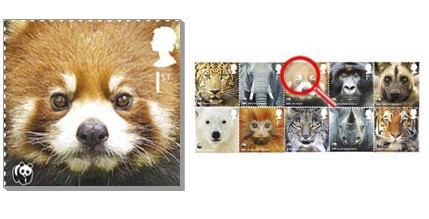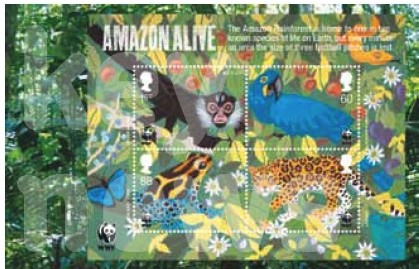
世界動植物基金成立於1961年。由一群著名的動植特專家發起成立,旨在解決國際環境爭端。英國皇家郵政為紀念這一組織於3月22 日特發行一套十枚紀念世界動植物基金成立五十周年的英國郵票。
同時發行與此題材呼應小型張。
英文詳細介紹如下:
The plants in detail
African Elephant - Elephants continue to face serious threats across their range. Although poaching of elephants for their ivory has declined since the 1989 worldwide ivory ban, a more long-term threat, is the reduction of habitat in the face of expanding human populations.
Mountain Gorilla - The mountain gorilla became known to science in 1902. Since then, they have endured uncontrolled hunting, war, disease, habitat destruction, and capture for the illegal pet trade.
Siberian Tiger - The Amur or Siberian tiger is the largest sub-species of tiger and is primarily found in south-eastern Russia and northern China. In the 1960s it was close to extinction but its numbers recovered to around 450 today.
Polar Bear - With 20-25,000 polar bears living in the wild, the species is not currently endangered, but its future is far from certain. If current warming trends continue, scientists believe that polar bears will be vulnerable to extinction within the next century.
Amur Leopard - Due to extensive habitat loss and conflict with humans, the Amur leopard’s situation is critical. However, the fact that the Amur tiger recovered from a precarious state of less than 40 individuals some 60-70 years ago gives conservationists hope.
Iberian Lynx - The Iberian lynx is classified as the world’s most endangered cat. Habitat loss and degradation are contributing to this decline. Today, there are no more than 38 breeding females in the wild.
Red Panda - The word panda comes from the Nepalese “poonya” which means bamboo eater. The red panda is known as the red cat bear or lesser panda. While it may be “lesser” in size than the giant panda, both species are threatened by less habitat and deforestation.
Black Rhinoceros - Relentless poaching, has seen the number of black rhino decline. Pressure escalated during the 1970s and 1980s because of rising demand for rhino horn in Asia and the Middle East and between 1970 and 1992, the black rhino suffered a 96% decline in numbers.
African Wild Dog - African wild dogs are the size of medium domestic dogs and their coats are mottled in shades of brown, black and beige. They have large, rounded ears and dark brown circles around their eyes. One of Africa’s most endangered carnivores it is Red listed as an endangered species.
Golden Lion Tamarin - The golden lion tamarin is listed as endangered by the IUCN. Only about 800 are left in the wild. The primary threats to this species’ survival are continued loss of forest habitat and population fragmentation due to agriculture and urban development
封面:
航空郵寄藍標
全套十枚
日戳
掛號條碼.....
英國電子郵票補資
英國航空掛號,3月22日倫敦寄出預計10天左右收到

世界動植物基金成立於1961年。由一群著名的動植特專家發起成立,旨在解決國際環境爭端。英國皇家郵政為紀念這一組織於3月22日特發行一套十枚紀念世界動植物基金成立五十周年的英國郵票。
同時發行與此題材呼應小型張。
英文詳細介紹如下:
Miniature sheet(face values subject to change):
1st Class – Spider Monkey -Spider monkeys are one of the largest primates in South America. Their prehensile tail allows them to find stability when sitting on branches and to reach out for food at the tip of fragile branches by suspending themselves with it.
60p – Hyacinth Macaw -In the 1980s an estimated 10,000 hyacinth macaws were illegally captured and sold as pets, while, the species’ natural habitat was being destroyed by deforestation. Local Indians also killed them to use the feathers to make tourist souvenirs.
88p – Poison Dart Frog -With its striking appearance and unique features, the poison dart frog is one of the most interesting and dangerous – Amazon species. The poison dart frog uses its brightly coloured skin to warn predators that it is “unfit to eat.” The skin secretes a dangerous poison that can paralyze and in some cases kill predators.
A. 代辦自然封貼套票用航空掛號銷一般日戳寄台灣 一封600元
B. 代辦自然封貼小全張用航空掛號銷一般日戳寄台灣 一封700元
英國似乎蓋紀念戳不能寄掛號,首日封也不好買,所以都只辦自然封
本項代辦~預計2011年3月21日截止,請在之前預訂並付代辦費用。
付款方式:
郵政劃撥 42035966 戶名:陳世清 請加付15元(郵局要扣的手續費)
ATM轉帳 0041063 0629924 共14碼(郵局轉帳請用轉入存薄,其他銀行跨行轉帳,銀行代碼為700)
ATM轉帳如果用跨行轉帳請通知你的帳號後四碼 以便查詢
洽詢:08-7360391 或 0926-104291預訂方式:
1.在討論區留言 (請用加密此帖 後面打大于20000)
2.私人訊息
3.站長信箱
4.站長EMAIL:shchin@chch.idv.tw
5.電話通知 08-7360391 ,0926104291注意事項:
1.本帖任何人都可以留帖,請先通知再匯款,勿直接匯來.
2.當你預訂時,你必須已經同意,版塊公告的幾點事項,以免日後糾紛。
3.請留預訂郵品名稱及數量及姓名地址(需英文地址),直接由英國寄到你的地址,地址是電腦列印的貼紙名條。
4.不想公開姓名地址,請用短消息,或版塊公告所說明的方式通知(方式有(方式有1.
給站長短訊 3.
站長信箱 4站長EMAIL:
shchin@chch.idv.tw 或
shchin.chen@msa.hinet.net5.電話通知 08-7360391 ,0926104291))。
5.留言可以加密帖,威望填20000,那只有管理員才看的到。